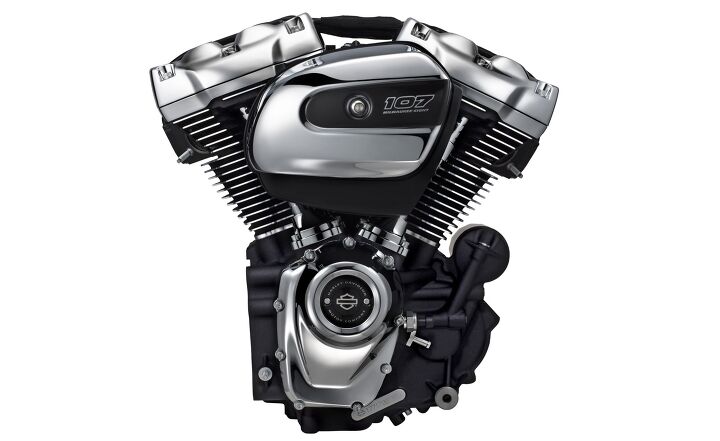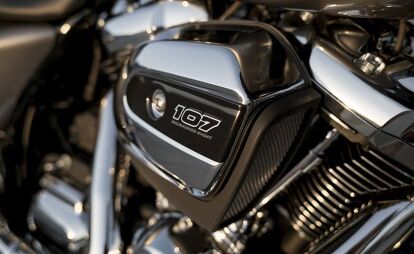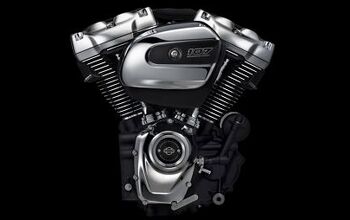Harley-Davidson Unveils The Milwaukee-Eight Engine For Touring Models

The ninth version of Harley-Davidson's Big Twin breaks cover
Well, we’ve joked about Harley-Davidson’s upcoming Milwaukee-Eight engine. We’ve prognosticated from EPA documents about what the Milwaukee-Eight would be. However, until now, we haven’t had the straight scoop about the ninth generation of the Motor Company’s Big Twin engines. After submitting ourselves to a variety of invasive tests, signing our lives away to gain entry into the Harley Media Department’s “circle of trust,” and waiting for the appointed hour to arrive, we can now tell you exactly what H-D has up its cylinder sleeves. However, the biggest news isn’t the part hidden in the sleeves at all.
SCOOP! Harley-Davidson Milwaukee-Eight Trademarked
The Milwaukee-Eight engine will come as part of the 2017 model line in two displacements and three varieties (Milwaukee-Eight 107, Twin-Cooled Milwaukee-Eight 107, and Twin-Cooled Milwaukee-Eight 114) and will be utilized in every 2017 Harley-Davidson Touring and Trike motorcycle model. That’s a 4% displacement increase over the previous 103 cu. in. and 110 cu. in. configurations. (For those of you interested in cubic centimeters instead of cubic inches, the new displacements translate into 1750cc and 1870cc, respectively.)
Harley-Davidson To Announce 107ci And 114ci “Milwaukee Eight” Engine
While an increase in displacement is always appreciated, the big news of the Milwaukee-Eight resides in the new heads, which have seen their valve count doubled to four valves-per-cylinder. No, that wasn’t an earthquake you just felt but rather the shock of Harley-Davidson breaking with tradition.
So, let’s take a look at what the new heads bring to the party. First, the new valve arrangement delivers a 50% increase in both intake and exhaust flow capacity, according to Harley. The valve train is maintenance-free thanks to hydraulic lifters which, after the initial factory lash setting, require no adjustment for the life of the engine. HD also states that the single camshaft is chain-driven and produces less friction and mechanical noise thanks to a simpler design. (Remember, less noise means more dB available for the exhaust note.) Additionally, the new heads combine with the pistons to bump the compression ratio – though HD is mum on how much. Unfortunately, we also don’t know tidbits, like bore and stroke, that gearheads are interested in learning.
These changes, along with the bumps in displacement, mean the rider has more power on tap. We’ll have to wait until we have a test unit in our possession to tell you how much, but according to Harley, we can expect the Milwaukee-Eight 107 to power from 0–60 11% quicker when compared to the Twin Cam High Output 103. The 60–80 mph top gear roll-on is also claimed to be 11% quicker. These numbers translate into two to three bike lengths and one to two bike lengths, respectively. The beefy Milwaukee-Eight 114 delivers a claimed 8% and 12% improvement in the 0–60 and 60–80 tests over the Twin Cam 110.
But wait! There’s more! Harley says that both engine variants deliver improved fuel efficiency, which translates, if tank capacity remains the same, into increased touring range along with that more powerful acceleration. All versions of the Milwaukee-Eight will include Assist and Slip Clutch to reduce clutch lever effort by 7% through improved hydraulics.
“The Milwaukee-Eight engine retains the classic Harley-Davidson 45-degree V-Twin design,” said Alex Bozmoski, Harley-Davidson Chief Powertrain Engineer, who led the development team. “It also retains the power characteristic that is the real legacy of the Harley-Davidson Big Twin: strong low-end torque with a broad, flat power curve through the mid-range that’s ideal for the touring motorcycle rider.”
Few areas affect rider comfort more than engine vibration and heat. In addition to rubber mounting, the Milwaukee-Eight addresses vibration through the use of a single counter balancer to negate a claimed 75% of primary vibration at idle. We’ll have to wait until we ride one to see if this affects vibration at cruising speed.
In the past, we’ve noted heat from the rear cylinder and exhausts during some of our road tests. The Milwaukee-Eight was designed to improve the rider’s and passenger’s experience of engine heat. The Milwaukee-Eight’s cooling methodology is based on the specific touring motorcycle model’s needs through the implementation of targeted cooling via either oil or liquid coolant directed to the hottest areas of the cylinder heads. More precise ignition timing is provided by a new knock sensor. The rear exhaust’s routing and the placement of the hot-running exhaust catalyst were altered to improve passenger comfort. Finally, the idle speed is down 150 rpm to 850 rpm for cooler running at a stop.
We all know how important styling is to Harley owners, and from the released pictures, the Milwaukee-Eight modernizes the classic Twin Cam’s lines with a slimmer primary drive giving riders an easier reach to the ground. A closer fitting air cleaner also adds leg room for racking up the miles.
“The Milwaukee-Eight engine is styled to project power,” said Brad Richards, Harley-Davidson Director of Styling. “I compare it to the back of an Olympic swimmer, lean in the waist but broad and muscular in the shoulders.” Richards continues with the comparison, “The rocker covers look like skin stretched taut over muscle, like the rocker arms are about to burst out of the engine. For the first time since the Knucklehead, the rocker covers reflect the action going on below. And they are massive. When you sit on the bike you can look down and see more of this engine.”
The three variations of the Milwaukee-Eight will be distributed throughout the H-D touring line:
Milwaukee-Eight 107: Street Glide/Street Glide Special, Road Glide/Road Glide Special, Electra Glide Ultra Classic, Road King and Freewheeler.
Twin-Cooled Milwaukee-Eight 107: Ultra Limited/Ultra Limited Low, Road Glide Ultra and Tri Glide Ultra.
Twin-Cooled Milwaukee-Eight 114: CVO Limited and CVO Street Glide.
While the new engine is stealing all the thunder of the initial 2017 Harley-Davidson announcement – for good reason – some other new additions should be noted, as well.
First, the touring line also receives an updated suspension package. Utilizing a single hydraulic adjustment knob, the emulsion piston rear shocks now offer 15-30% more range of preload adjustment than previously available. “Preload can now be adjusted to match the load of rider, passenger and gear without tools or an air pump,” said Paul James, Harley-Davidson Director of Motorcycle Product Planning. “Once set, the preload will not leak down or require further adjustment.” Second, the fork wasn’t left out of the upgrades, either. For 2017 the front suspension utilizes Showa SDBV technology for the linear damping performance of a cartridge fork and a reduction in weight.
Given that this is only the ninth revision of the Harley-Davidson Big Twin engine, we’re chomping at the bit for our opportunity to actually sample the 2017 touring models’ new engines and suspension. The good news is that we’ll be throwing a leg over a selection of new Harley’s next week in the Pacific Northwest and be reporting back to you as quickly as possible. To actually get to see the 2017s in three dimensions, you’ll have to wait until September 23 when Harley dealerships across the country open their doors for test rides of the 2017 Harley-Davidson touring models and the new Milwaukee-Eight engine.

Like most of the best happenings in his life, Evans stumbled into his motojournalism career. While on his way to a planned life in academia, he applied for a job at a motorcycle magazine, thinking he’d get the opportunity to write some freelance articles. Instead, he was offered a full-time job in which he discovered he could actually get paid to ride other people’s motorcycles – and he’s never looked back. Over the 25 years he’s been in the motorcycle industry, Evans has written two books, 101 Sportbike Performance Projects and How to Modify Your Metric Cruiser, and has ridden just about every production motorcycle manufactured. Evans has a deep love of motorcycles and believes they are a force for good in the world.
More by Evans Brasfield



































Comments
Join the conversation
Woo hoo! Welcome to where the competition was at back in the 1980's...
I kid of course. Surely meeting stricter emissions regs was the impetus for this change, but more efficiency and power too, without messing with the fundamental appeal of the Harley engine is a win.
I wonder what the nickname for this one will be. The rocker covers have those bulges in them. "Zithead", perhaps ;)
HD , welcome to the 20'th century......too bad it's the 21'ST century.
Honda's Gold Wing still rules.....as usual!